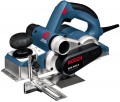Power consumption
The total power consumed by the electric planer during operation. The more powerful the tool, the generally higher its productivity and the better it is suitable for large volumes of work and/or hardwoods. Here, however, it must be taken into account that the effective power (the power supplied by the unit directly to the working tool) is anyway lower than the consumed one, but it is far from always indicated. Therefore, it is quite possible to compare different models with each other precisely in terms of power consumption.
Note that more power means higher electricity consumption, and also, most often, more weight and cost of the tool. Therefore, it does not always make sense to chase the most powerful units. So, for occasional use and small volumes of work, a power of 500-600 W is considered quite sufficient; for regular work on relatively soft wood, 700-800 W is enough, and professional models have a power of more than 1000 W.
Rotation speed
The maximum speed of rotation of the working tool of the electric planer — a drum with knives attached to it. In modern models, this figure is practically never lower than 10,000 rpm (otherwise it is impossible to ensure normal quality of work), and in most cases it is in the range of 11,000 – 17,000 rpm. It is believed that the higher the number of revolutions, the more evenly the workpiece is processed and the smoother the surface is obtained; and the overall speed of work will be higher. On the other hand, a high speed also requires high engine power, especially when working with hardwoods; for such materials, it makes sense to use a low-speed tool — it will provide more efficient power distribution.
Grooving depth
The greatest depth of the groove that can be cut into the workpiece with a planer.
Grooves are narrow and long slots used, in particular, for tenoning wooden parts. Some models of electric planers are equipped with special tools that make it easier to cut grooves.
In box
—
Dust collector. The presence of a dust collector in the delivery set — a special bag for collecting dust, chips and other waste that occurs during operation. This bag connects directly to the waste chute, so that the waste stays in the dust bin and cleaning up after work becomes much easier. However the dimensions of the tool with the bag attached increase somewhat, and during work it is necessary to monitor its filling and release it in time — otherwise the accumulated chips can jam or even break the planer.
—
Case (bag). The presence in the delivery set of a special case — a suitcase for storing and carrying a tool, which also provides some degree of protection. Using a case for such purposes is much more convenient than various "non-native" packages: it is optimally adapted to a specific planer model, in addition, it often has specialized compartments for additional accessories. There are also rag bags, lighter, but at the same time less protective.
Noise level
The maximum noise level produced by the planer during operation. The lower this indicator, the more comfortable the use of the tool, the less inconvenience it creates for both the user and others. Note that the noise level is measured in decibels, and this is not a linear unit — in other words, sounds with a difference of several dB in volume can differ significantly. A few examples for comparison: 75 dB noise is approximately equivalent to a scream, 80 dB is a motorcycle engine, 85 dB is a loud scream, 90 dB is the sound of a freight car moving at a distance of 5-6 m, 95 dB is the noise inside a subway car.
Power cord length
The length of the network cable can tell you how far from the outlet you can operate the device. Therefore, for domestic use, it is more relevant to choose models with a short cord, for construction work or use in production, in the garage a longer cable is better.

